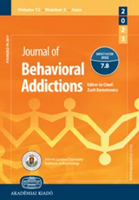Compulsive sexual behavior disorder in 42 countries: Insights from the International Sex Survey and introduction of standardized assessment tools
Compulsive sexual behavior disorder in 42 countries: Insights from the International Sex Survey and introduction of standardized assessment tools
Author(s): Beáta Böthe, Mónika Koós, Léna Nagy, Shane W. Kraus, Zsolt Demetrovics, Marc N. Potenza, Aurélie Michaud, Rafael Ballester-Arnal, Dominik Batthyány, Sophie Bergeron, Joël Billieux, Peer Briken, Julius Burkauskas, Georgina Cárdenas-López, Joana Carvalho, Jesús Castro-Calvo, Lijun Chen, Giacomo Ciocca, Ornela Corazza, Rita Csako, David P. Fernandez, Elaine F. Fernandez, Julien Fournier, Hironobu Fujiwara, Johannes Fuss, Roman Gabrhelík, Ateret Gewirtz-Meydan, Biljana Gjoneska, Mateusz Gola, Joshua B. Grubbs, Hashim T. Hashim, Md Saiful Islam, Mustapha Ismail , Martha C. Jiménez-Martínez, Tanja Jurin, Ondrej Kalina, Verena Klein, András Költő, Chih-Ting Lee, Sang-Kyu Lee, Karol Lewczuk, Chung-Ying Lin, Christine Lochner, Silvia López-Alvarado, Kateřina Lukavská, Percy Mayta-Tristán, Ionut Milea, Dan J. Miller, Oľga Orosová, Gábor Orosz, Fernando P. Ponce, Gonzalo R. Quintana, Gabriel C. Quintero Garzola, Jano Ramos-Diaz, Kevin Rigaud, Ann Rousseau, Marco De Tubino Scanavino, Marion K. Schulmeyer, Pratap Sharan, Mami Shibata, Sheikh Shoib, Vera L. Sigre Leirós, Luke Sniewski, Ognen Spasovski, Vesta Steibliene, Dan J. Stein, Julian StrizekSubject(s): Individual Psychology, Social psychology and group interaction, Clinical psychology, Behaviorism, Health and medicine and law
Published by: Akadémiai Kiadó
Keywords: addictive behavior; assessment; compulsive sexual behavior; cross-cultural; International Sex Survey (ISS); validation;
Summary/Abstract: Despite its inclusion in the 11th revision of the International Classification of Diseases, there is a virtual paucity of high-quality scientific evidence about compulsive sexual behavior disorder (CSBD), especially in underrepresented and underserved populations. Therefore, we comprehensively examined CSBD across 42 countries, genders, and sexual orientations, and validated the original (CSBD-19) and short (CSBD-7) versions of the Compulsive Sexual Behavior Disorder Scale to provide standardized, state-of-the-art screening tools for research and clinical practice. Method: Using data from the International Sex Survey (N 5 82,243; Mage 5 32.39 years, SD 5 12.52), we evaluated the psychometric properties of the CSBD-19 and CSBD-7 and compared CSBD across 42 countries, three genders, eight sexual orientations, and individuals with low vs. high risk of experiencing CSBD. Results: A total of 4.8% of the participants were at high risk of experiencing CSBD. Country- and gender-based differences were observed, while no sexual-orientation-based differences were present in CSBD levels. Only 14% of individuals with CSBD have ever sought treatment for this disorder, with an additional 33% not having sought treatment because of various reasons. Both versions of the scale demonstrated excellent validity and reliability. Discussion and conclusions: This study contributes to a better understanding of CSBD in underrepresented and underserved populations and facilitates its identification in diverse populations by providing freely accessible ICD-11-based screening tools in 26 languages. The findings may also serve as a crucial building block to stimulate research into evidence-based, culturally sensitive prevention and intervention strategies for CSBD that are currently missing from the literature.
Journal: Journal of Behavioral Addictions
- Issue Year: 12/2023
- Issue No: 2
- Page Range: 393-407
- Page Count: 15
- Language: English

